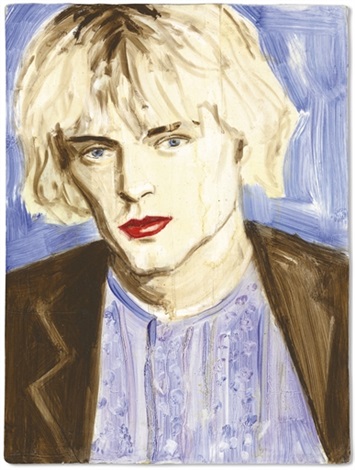Through a distinctive and vivid portrayal of her subjects, Elizabeth Peyton, an American artist, has made a great contribution to the art world of our days. From famous people to historical ones, Peyton’s paintings are full of romance and nostalgia, inducing the viewer to dive into the characters’ minds. Among her famous works, “Kurt” is one of those few that grant us an access into the life and legacy of the legendary artist Kurt Cobain.
Who was Elizabeth Peyton?

Elizabeth Peyton, a young American artist born in 1965, is well known for her specific style of portraiture that often depicts the personalities of celebrities, friends and historical figures. Throughout her career of many decades, Peyton’s work exhibits an intimate and emotional field of vision, which is usually infused with romanticism and nostalgia.
FUN FACT: In an unexpected turn of events, Elizabeth Peyton’s artwork once found its way onto the set of a popular television show. Peyton’s portrait of the iconic musician Kurt Cobain caught the eye of the production team behind the hit series “Friends.”
Her Career
Peytons’s artistic adventure started in the late 80s when she attended the School of Visual Arts in New York City. Before long, she became known for her moving portraits. The diverse sources of her inspirations ranged from literature, music, and pop culture. Throughout the years, Peyton’s works have been displayed in many galleries and museums internationally according to which she is recognized as a major figure of contemporary art in her generation.
What is Happening in “Kurt”?

| Artist | Elizabeth Peyton |
| Date Created | 1995 |
| Medium | Oil on board |
| Genre | Portraiture |
| Period | Contemporary |
| Dimensions | 32 x 24 inches (81.3 x 61 cm) |
| Series/Versions | N/A |
| Where is it housed? | Private collection/public exhibition |
Among the most significant pieces of Peyton’s career is the portrait named “Kurt,” portraying the legendary artist Kurt Cobain who was the Nirvana’s frontman. Having been created in 1995, which was just a year after Cobain’s tragic death.
Peyton, in “Kurt,” offers a grippingly personalized portrayal of Cobain, capturing him with a certain reverence and tenderness. The delicate brushwork of the artist creates an atmosphere of fragility that mirrors the conflicting inconsistencies of Kurt Cobain both artistically and humanly.
Interesting Facts about “Kurt”
Emotional Depth: Peyton’s portrait of Kurt Cobain is not merely a depiction of a famous musician, but a poignant exploration of human emotion and vulnerability. The artist’s ability to convey such depth and complexity in her subjects is a testament to her mastery of the medium.
Connection to Music: As a lifelong fan of music, Peyton’s work often explores the intersection between art and music. “Kurt” serves as a tribute to Cobain’s enduring legacy as a cultural icon and musical pioneer, capturing the essence of his artistic spirit.
Cultural Impact: Since its creation, “Kurt” has become an iconic image in popular culture, symbolizing the tragic yet enduring legacy of Kurt Cobain. The painting has been reproduced in various forms, from posters to album covers, further cementing its status as a cultural touchstone.
Frequently Asked Questions
Why is Elizabeth Peyton important?
Peyton’s portraiture has frequently included a wide range of figures. While she often depicts artists, writers, singers, and actors, she is perhaps most recognized for her portrayals of both those in her personal life and those from beyond it, such as close friends, historical figures, and symbols of modern society.
Who is Elizabeth Peyton inspired by?
Despite the fact that figurative painting was incredibly unpopular at the time, Peyton managed to achieve both critical and commercial success with her sumptuous, blatantly affectionate portraits. These portraits featured friends, historical people, and, most famously, pop heroes.
Conclusion
Elizabeth Peyton’s “Kurt” transcends a mere portrait, becoming a meditation on the transformative nature of art. Elegantly, sensitively, and profoundly, the painting captures the very essence of a cultural icon. As we admire this melancholic portrait, we are inevitably reminded of the lasting legacy of Kurt Cobain and the imperishable effect of his music on the world.













